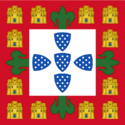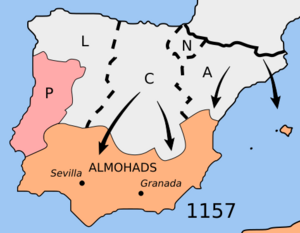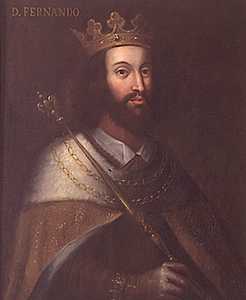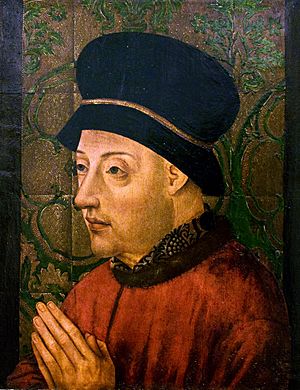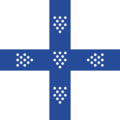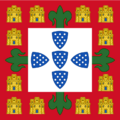Portugal in the Middle Ages facts for kids
Quick facts for kids
Kingdom of Portugal
|
|||||||||
|---|---|---|---|---|---|---|---|---|---|
| 1139–1415 | |||||||||

Portugal and the Iberian Peninsula around 1160
|
|||||||||
| Capital | Cohymbra (1139–1255) Lixboa (1255–1415) |
||||||||
| Common languages | |||||||||
| Religion | Roman Catholicism | ||||||||
| Government | Monarchy | ||||||||
| King | |||||||||
|
• 1139–1185
|
Afonso I (first) | ||||||||
|
• 1385–1433
|
João I (last) | ||||||||
| Historical era | Middle Ages | ||||||||
| 25 July 1139 | |||||||||
| 5 October 1143 | |||||||||
| 1383–1385 | |||||||||
| 14 August 1415 | |||||||||
| Currency | Dañerio | ||||||||
| ISO 3166 code | PT | ||||||||
|
|||||||||
The Kingdom of Portugal was a country in Europe that existed from the 1130s to 1910. It started as the County of Portugal and was ruled by the Portuguese House of Burgundy. For a long time, Portugal's history was about slowly taking back land from Muslim rulers. This process is called the Reconquista.
This important task was mostly finished when Afonso III of Portugal became king. He was the first to call himself "King of Portugal and the Algarve." The period after Afonso III's death in 1279 saw a big change. Portugal went through a time without a clear ruler, known as the 1383–1385 Portuguese interregnum. After this, a new royal family, the House of Aviz, took over.
Contents
How Portugal Began
The Rise of Count Henry
Around the late 1000s, knights from all over Europe came to help the kings of León, Castile, and Aragon. They fought against the Moors, who were Muslim rulers in the Iberian Peninsula. One of these knights was Henry of Burgundy.
In 1095, Henry married Teresa of León. She was the daughter of Alfonso VI of León and Castile. Teresa's dowry included the County of Portugal. Count Henry ruled this land, protecting Alfonso VI's borders from Moorish attacks.
Afonso Henriques Takes Control
When Alfonso VI died in 1109, he left his lands to his daughter, Urraca. Count Henry tried to take over León, but he died in 1112. His wife Teresa then ruled Portugal north of the Mondego River. South of the river, the Moors were still in charge.
Teresa continued fighting against Urraca. She was even captured once but later freed. She gave many gifts and titles to her ally, Fernando Pérez de Traba. This made her son, Afonso Henriques, and other nobles unhappy.
Afonso Henriques, born around 1109, became Count of Portugal in 1112. He was still very young. By age 11, Afonso had his own ideas, different from his mother's. In 1120, he sided with the Archbishop of Braga, who was Teresa's enemy. Both were sent away by Teresa.
In 1122, Afonso turned 14, which was considered adult age then. He became a knight and gathered an army. Near Guimarães, at the Battle of São Mamede (1128), he defeated his mother's allies. He captured Teresa and sent her to a monastery. She died in 1130. Afonso then became the sole ruler of Portugal. He also defeated his cousin, Alfonso VII of León and Castile, freeing Portugal from León's control. In 1129, Afonso declared himself Prince of Portugal.
Becoming a Kingdom
Afonso then focused on fighting the Moors in the south. His campaigns were very successful. On July 25, 1139, he won a huge victory at the Battle of Ourique. Right after, his soldiers declared him King of Portugal. This meant Portugal was now an independent kingdom, not just a county of León.
However, independence needed to be recognized by other countries and, most importantly, by the Catholic Church and the Pope. Afonso married Matilda of Savoy and sent messengers to Rome. He built monasteries and gave special rights to religious groups.
In 1143, Afonso wrote to Pope Innocent II. He declared Portugal a servant of the Church and promised to fight the Moors. He said he was a direct vassal of the Pope, bypassing the King of Castile or León. Afonso continued his fight, taking Santarém and Lisbon from the Moors in 1147.
Peace and Recognition
King Alfonso VII of León still saw Afonso as a rebel. They fought often. Afonso joined forces with the King of Aragon against Alfonso VII. To make this alliance stronger, Afonso's son Sancho was engaged to Dulce, a princess of Aragon.
Finally, in 1143, the Treaty of Zamora brought peace between the cousins. The Kingdom of León officially recognized Portugal as an independent kingdom. Afonso continued to fight border wars with his Christian and Moorish neighbors.
In 1167, war started again. Afonso conquered part of Galicia. But while trying to capture Badajoz, he was wounded and captured by Ferdinand II of León in 1169. Ferdinand was Afonso's son-in-law. He released Afonso, who promised to give up his conquests in Galicia.
In 1179, the Church repaid Afonso's loyalty. In a special letter called a papal bull (Manifestis Probatum), Pope Alexander III recognized Afonso as King. He also said Portugal was an independent country with the right to take land from the Moors. This papal blessing secured Portugal's independence.
Afonso died on December 6, 1185. He had made Portugal an independent kingdom and expanded its borders southwards.
The Reconquista in Portugal
Afonso I had many victories against the Moors. At the start of his rule, the Muslim power was weakening. Independent Moorish leaders ruled cities, ignoring their central government. Afonso used these divisions to invade Alentejo, helped by the Knights Templar and Knights Hospitaller.
On July 25, 1139, he defeated the Moors at Ourique. While the legend says he defeated 200,000 Muslims, the battle was not fully decisive. In 1140, the Moors took back Leiria, a fortress Afonso built. In 1144, they defeated the Templars.
But on March 15, 1147, Afonso stormed Santarém. Around the same time, crusaders on their way to Palestine landed in Porto. They helped Afonso in the siege of Lisbon. Many of these crusaders were from France, England, and Germany. With their help, Afonso captured Lisbon on October 24, 1147.
This was his greatest military success. Moorish strongholds like Palmela, Sintra, and Almada soon surrendered. In 1158, Alcácer do Sal, a major trading center, was captured. However, a new Muslim group, the Almohad Caliphate, arrived from Africa. They stopped the Portuguese advance for a while.
In 1171, Afonso made a seven-year truce with the Moors. He was old and wounded, so his son Sancho led the army. Between 1179 and 1184, the Moors took back some land in Alentejo. But they could not retake Santarém and Lisbon.
Afonso died on December 6, 1185. He had secured Portugal's independence and expanded its territory. He also started the navy and worked with military orders. This cooperation was very important for Portugal's future explorations.
Sancho I: The Populator
Sancho I continued the war against the Moors. In 1189, he captured Silves, the capital of Algarve. But in 1192, he lost Algarve and much of Alentejo back to the Almohads. A peace agreement was then made.
For the next eight years, Sancho fought against Alfonso IX of León. This struggle was not clear. It ended in 1201. The last ten years of Sancho's rule were peaceful. He earned the nickname o Povoador, "the Populator."
He gave new rights to many cities, helping them govern themselves. Lisbon had already received its rights in 1179. Sancho also encouraged people to move to and farm new lands. He gave land to military orders and towns if they would cultivate it.
Towards the end of his reign, he had a disagreement with Pope Innocent III. Sancho wanted priests to go to battle and be judged by secular courts. He also held back money owed to Rome. He eventually made peace with the Pope in 1210. He died in March 1211.
Afonso II and Sancho II
Afonso II's Reign
The reign of Afonso II (1211–1223) was important because it saw the first meeting of the Portuguese Cortes. This was a gathering where Church leaders and nobles were called by the king.
Afonso II was not a warrior. But in 1212, Portuguese soldiers helped the Castilians defeat the Moors at the Battle of Las Navas de Tolosa. In 1217, Portuguese leaders and foreign crusaders retook Alcácer do Sal.
Afonso II did not follow his father's will. He refused to give land to his brothers, who went into exile. He only gave land to his sisters after a civil war. He also tried to make the monarchy stronger and get more money by taking from the Church. This led to him being excommunicated by Pope Honorius III. Portugal remained under Church punishment until Afonso II died in 1223.
Sancho II's Challenges
Sancho II became king at age 13. To lift the Church punishment, his father's main advisors resigned. Estêvão Soares, the archbishop of Braga, led nobles and churchmen who wanted more power. He made an alliance with Alfonso IX of León.
Elvas was taken from the Moors in 1226. In 1227, Sancho took control of the kingdom. He continued the fight against the Moors, driving them from their last strongholds in Alentejo. He also won many victories in the Algarve between 1239 and 1244.
However, his rule was cut short by a rebellion in 1245. This was partly because of his marriage to Mécia Lopes de Haro from Castile. The bishops, unhappy with Sancho's anti-Church advisors, used this marriage as an excuse. They found a leader in Sancho's brother, Afonso. The Pope supported Afonso. Sancho II went to Toledo, where he died in 1248.
Afonso III: Unifying Portugal
Afonso III became king. He stopped using older titles and declared himself the true king. This was a big step in making the monarchy stronger and creating a central government.
Soon after, Portugal conquered Algarve, the last Moorish stronghold. This angered Alfonso X of Castile, who claimed Algarve. The war ended when Afonso III agreed to marry Beatriz de Guzmán, Alfonso X's daughter. He would hold Algarve as a fief (land held in exchange for loyalty) from Castile.
This marriage caused problems because Afonso III's first wife was still alive. The kingdom was again put under Church punishment. In 1254, Afonso III called the Cortes (assembly) in Leiria. Cities, nobles, and clergy were all represented.
With their support, the king refused to give in to Rome. At the Cortes of Coimbra (1261), he gained more support from the cities. He agreed that taxes could not be put in place without the Cortes' approval. The Church suffered more from the long punishment. In 1262, Pope Urban IV approved the marriage and made Denis (the future king) legitimate. This ended the struggle between the Church and the Crown.
The monarchy became powerful by defending national interests and getting support from cities and military orders. In 1263, Alfonso X gave up his claim to Algarve. Lisbon became the capital. Afonso III ruled until his death in 1279.
Denis I: The Farmer King
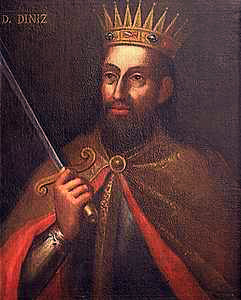
King Denis faced social, economic, and constitutional challenges. His reign was not always peaceful. At first, his brother Afonso challenged his right to be king, leading to a short civil war.
Peace with León and Castile was made in 1297. Denis's daughter Maria married Alfonso XI of Castile. Denis's son Afonso married Beatrice of Castile. Another civil war between Denis and his son was stopped in 1293 by Queen Elizabeth of Portugal. She was known for her good deeds and helped arrange peace.
These wars were short. Denis focused on rebuilding society. He ordered many castles to be built and created new towns. He also gave special rights to several cities. He encouraged people from the north to settle in the south and interior of Portugal.
Denis also tackled economic problems. War had left much farmland empty. Trade and education had suffered. Denis started important reforms. He was called the rei lavrador or "farmer king" because he brought in better farming methods and started agricultural schools.
He boosted sea trade by making a trade agreement with England (1294). He also created a royal navy in 1317, led by a Genoese admiral. In 1290, he founded the University of Coimbra. He was also a poet and supported literature and music. He declared Portuguese the official language of the state.
Denis made the government more central and limited the power of local courts. He also supported and nationalized military orders. The Order of Christ, formed in 1319, played a big role in Portugal's future explorations.
Afonso IV and Peter I
Afonso IV: The Brave
Afonso IV continued his father's marriage policies. His daughter Maria married Alfonso XI of Castile in 1328. But this marriage actually caused a war. Peace was restored in 1330 after Queen Isabella stepped in again.
Afonso IV's son, Peter, married Constance. Afonso IV led a strong Portuguese army to help the Castilians fight the Moors from Granada. In the Christian victory at the Battle of Río Salado in 1340, he earned the title Afonso the Brave. In 1347, he married his daughter Eleanor to Peter IV of Aragon. His later years were sad due to the tragedy of Inês de Castro. He died in 1357.
Peter I: The Just
Peter I of Portugal loved justice and often handled cases himself, sometimes with great strictness. His first act was to punish those who murdered Inês de Castro. Throughout his rule, he made the central government stronger. He did this by strictly enforcing laws and order, limiting the power of nobles and the Church.
In 1361, at the Cortes of Elvas, it was decided that Church privileges were only valid if they did not go against the king's power. Peter kept good relations with England. In 1352, Edward III helped Portuguese traders. In 1353, a trade agreement was signed between Portugal and London merchants.
The kings Denis, Afonso IV, and Peter I had mostly kept peace with other Christian kingdoms in Iberia. Because of this, Portugal grew in wealth and culture. People supported the monarchy because it was a national institution that stood against the power of nobles and clergy.
Ferdinand I and the Interregnum
Ferdinand I's Rule
Ferdinand I claimed the thrones of León and Castile after King Peter of Castile died in 1369. He based his claim on his grandmother, Beatrice, who was from the legitimate Castilian line. Most Castilian nobles did not accept a Portuguese king and welcomed Henry II of Castile.
Ferdinand then allied with the Moors and Aragon. But in 1371, Pope Gregory XI stepped in. It was decided that Ferdinand should give up his claim and marry Eleanor, Henry's daughter. However, Ferdinand chose his Portuguese mistress, Leonor Telles de Menezes, and married her instead.
To get revenge, Henry of Castile invaded Portugal and besieged Lisbon. Ferdinand asked John of Gaunt from England for help. John of Gaunt also claimed the Castilian throne. Portugal and England formed an alliance. Ferdinand made peace with Castile in 1374. But he renewed his claim in 1380 after Henry of Castile died.
In 1381, Richard II of England sent troops to Lisbon. He also arranged for his cousin Prince Edward to marry Beatrice, Ferdinand's only child. Beatrice had been recognized as the heir to the throne by the Cortes of Leiria in 1376.
In 1383, Ferdinand made peace with John I of Castile at Salvaterra, leaving his English allies. The English then attacked parts of his land. The Treaty of Salvaterra stated that Beatrice would marry John I. Six months later, Ferdinand died. According to the treaty, Leonor became regent (ruler until the heir was old enough).
The Portuguese Interregnum
Leonor had a close relationship with the Count of Ourém. He was involved in many plots with England and Castile. Nobles disliked his influence, and Leonor's strict rule caused much anger. The unhappy people chose D. John, the grand-master of the knights of Aviz and an illegitimate son of Peter I, as their leader.
They started a revolt in Lisbon and killed the Count of Ourém in the royal palace on December 6, 1383. Leonor fled to Santarém and asked Castile for help. D. John was declared the defender of Portugal. In 1384, a Castilian army attacked Lisbon. But the Portuguese fought bravely. After five months, a plague forced the Castilians to end the siege. John I of Castile then imprisoned Leonor in a convent, where she died in 1386.
In 1384, Nuno Álvares Pereira, who would become a great military leader, defeated the invaders at the Battle of Atoleiros.
John I: A New Dynasty and Empire Begins
On April 16, 1385, the Cortes (assembly) in Coimbra decided they had the right to choose John of Aviz as their new king. John was then elected King of Portugal. This event showed the strong national character of the monarchy. Choosing the grand-master of Aviz strengthened the alliance between the Crown and military orders. His election by the Cortes also included nobles and the Church.
Ferdinand had been the last legitimate descendant of Count Henry of Burgundy. With John I, a new royal family, the House of Aviz, began to rule. The most urgent task for the new king was the threat of Castilian attacks. John of Castile marched into Portugal with a large army in August 1385.
Victory at Aljubarrota

On August 14, the Portuguese, though greatly outnumbered, completely defeated the Castilians and their French allies at Aljubarrota. This victory showed that the Portuguese military was equal to their strongest rivals. In October, the Portuguese military leader invaded Castile and won another victory at Valverde.
Early the next year, John of Gaunt and 5,000 English soldiers arrived to help John I. They launched another attack on Castile, but it was not successful. The Treaty of Windsor (May 9, 1386) confirmed and strengthened the alliance between Portugal and England. With this strong alliance, the Castilians were powerless.
A treaty was made in 1387 and renewed over time. Peace was finally made with the Treaty of Ayllón in 1411.
Beginning of the Portuguese Empire
John I ruled until his death in 1433. At home, he tried to improve government, encourage farming and trade. He also kept the nobles loyal by giving them land and privileges. Abroad, he aimed for peace with Castile and a close friendship with England.
In 1387, he married Philipa of Lancaster, daughter of John of Gaunt. English kings like Richard II and Henry IV continued to support the Treaty of Windsor.
The Cortes of Coimbra, the battle of Aljubarrota, and the Treaty of Windsor were the final steps in making the monarchy strong. A period of overseas expansion began during John I's reign with the capture of Ceuta in Morocco.
The three oldest sons of King John and Queen Philippa (Edward, Peter, and Henry, later known as Henry the Navigator) wanted to prove themselves by fighting the Moors. In 1415, a Portuguese fleet, led by the king and his sons, sailed to Ceuta. The town was captured and guarded. This was the first Portuguese outpost in Africa, marking the start of the Portuguese Empire.
Flags of Portugal during the Middle Ages
Five different flags were used between 1139 and 1415. They changed over time from a simple blue cross on white to a more complex design with a red border.
See also
- Portuguese monarchs


